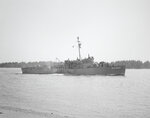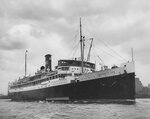 Narrowsburg
NarrowsburgLight Rain Fog/Mist, 43°
Wind: 8.1 mph
 Narrowsburg
NarrowsburgA Honesdale resident and history enthusiast suggested a story about a ship, the USS Honesdale, originally commissioned by the U.S. Navy as PC-566.
The story of the Honesdale turned out to be …
Stay informed about your community and support local independent journalism.
Subscribe to The River Reporter today. click here
This item is available in full to subscribers.
Please log in to continue |


A Honesdale resident and history enthusiast suggested a story about a ship, the USS Honesdale, originally commissioned by the U.S. Navy as PC-566.
The story of the Honesdale turned out to be surprising. It includes a German submarine, the U-166; a steam passenger freighter, the SS Robert E. Lee; and an attempted attack by the Nazis on the U.S. during World War II.
The official story
The following history of PC-566 was taken from the U.S. Navy’s Naval History and Heritage Command collection.
PC-566 was laid down by Brown Shipbuilding Co., Houston, TX, on 14 August 1941; it launched on 31 March 1942, sponsored by Miss Ruby Joyce Halfin; and was commissioned on 15 June with Lt. Cmdr. H. G. Claudius in command.
After shakedown, when a ship’s performance is tested, PC-566 was assigned to patrol and escort operations in the Gulf of Mexico and the Caribbean. The submarine chaser remained in the Florida-Caribbean area on patrol and escort duty and also served as a training ship out of Miami.
In March 1945, she was attached to the Fleet Experimental Sonar School, Key West, then resumed duties the following month at the Naval Training Center in Miami.
After World War II, PC-566 continued training exercises along the East Coast, and in the Caribbean until late 1946. PC-566 was decommissioned on 8 January 1947, and joined the Atlantic Reserve Fleet.
While berthed at Norfolk, on 1 February 1956 the ship was renamed Honesdale. Honesdale was struck from the Navy List on 1 July 1960 and sold to Venezuela in June 1961. There she was renamed the ARV Calamar, with hull ID P-02.
The real story
The previous paragraphs seem rather cut and dried. They omit any mention of the dangerous mission entrusted to the ship's commander and crew.
During World War II, 58 ships were sunk in the Gulf of Mexico, according to a U.S. Coast Guard page on its aviation history.
The area, notes naval historian C.J. Christ, writing for the Houma Courier in Louisiana in 2004, “had the unenviable distinction of being the heaviest concentration of torpedoed merchant ships in the world.”
Before the end of July 1942, only about a month after arriving at the Sub Chaser Training School, Lt. Comm. Herbert Gordon Claudius, USNR, received orders to gather up his crew and go immediately to a point north of Key West, FL. He was to escort a steam-powered passenger freighter, the SS Robert E. Lee, headed to Tampa from Trinidad and then on to New Orleans.
The Robert E. Lee was carrying 407 people, many of whom were rescued victims from other U-boat attacks. With no harbor pilot available to guide the ship into the harbor at Tampa, the destination was set for New Orleans, Christ wrote.
On July 30, 1942, the two vessels were in the Gulf of Mexico about 45 miles south of the Mississippi Delta.
So was the German submarine U-166. It fired a torpedo that struck the Robert E. Lee midship, sending it to the bottom of the Gulf in about 15 minutes.
The watchmen on the PC-566 observed the wake from the periscope of the sub and closed the distance with all hands at battle stations. A barrage of depth charges was set loose and a large oil slick was observed at the surface by the men on watch aboard the sub chaser.
With no indication of the sub’s survival, Commander Claudius focused his attention on rescuing survivors from the Lee.
Even so, 25 civilians died, Christ wrote.
A few days later, a small military aircraft flying out of Houma, LA, reported sighting a U-boat at the surface about 140 miles away from the sinking of the Lee. It dropped its munitions and claimed to see an oil slick.
It was given credit for sinking the U-166.
The controversy
Lt. Commander Claudius’ superior officers’ review of the attack concluded that due to the lack of training and experience of the commander and crew, and because of their actions in response to the threat, the commander was given a grade of “F,” according to C.J. Christ.
The accounts of Lt. Commander Claudius and those of his crew were dismissed.
The sinking of the U-166 was attributed to the aircraft.
History rewritten
The sunken U-boat was spotted in 2001 by a survey crew for Shell and British Petroleum.
Explorer Robert Ballard—famed for finding the wreckage of the Titanic—had a look at the site in 2014. He and his researchers sent down robots, which found the sub lying in two sections.
The expedition is chronicled in a PBS documentary, “Nazi Attack on America,” which aired in 2015.
The findings changed the way historians saw the sinking of the U-boat. They led to the conclusion that one of the depth charges landed on the deck of the sub directly above the torpedos, and when it exploded, it also caused the torpedos to explode.
Ultimately, Commander Claudius and the crew of the PC-566 were given credit for destroying the U-boat.
But the heroic commander died in 1981.
So his son, Herbert Gordon Claudius Jr., received a Legion of Merit medal in his father’s honor at the Pentagon on December 26, 2014, according to Stars and Stripes, which covered the ceremony.
The USS Honesdale
After reading all of this, did you pick up that this vessel was renamed on February 1, 1956, to the USS Honesdale?
But little is known about that.
A request to the National Archives for information shed a little light.
The naming of the Honesdale occurred when the PC-566 was decommissioned and in the naval reserve fleet, wrote Nathaniel Patch of the National Archives in an email.
Reserve fleet records, considered temporary, are not retained, Patch wrote, so no further information from the National Archives was available.
That information came from records kept by the Bureau of Ships—which would normally keep records about the renaming of commissioned ships—but because the PC-566 was decommissioned at the time of her naming, those records were not kept either.
That means there is still some missing information that I hope to be able to reveal at a later date.
What were the PCs?
These small U.S. Navy ships were manned by a crew of 65 officers and enlisted men. They were well known for being notoriously unforgiving in stormy seas, wrote William J. Veigele, U.S. Naval Reserve (Ret.) in his book “PC Patrol Craft of World War II.”
The book chronicles the story of these ships and describes what life was like on board them.
The author draws from personal experiences and memories of his own, as well as those of his shipmates, to describe life aboard the patrol ships during World War II.
Because the ships escorted other vessels through waters patrolled by U-boats, they were constantly in harm’s way.
They were attacked by torpedoes and kamikaze pilots or from shore as they led landing craft to the invasion beaches.
After the war, many of these ships were “mothballed” (put to anchor for extended periods), decommissioned, repurposed, scrapped or sold. Some of the ships went on to serve the country after the war.
There are no known remaining preserved PCs—only rusted deteriorating remnants in scrap yards, Veigele writes.
Sixteen shipyards had built 361 PCs by the end of WWII. These ships were steel-hulled, 173-feet long, 450-ton, diesel-engined-powered patrol craft that were “too small and too numerous for the Navy to dignify with names—only the bold black PC emblazoned on the bow of their hulls followed by their number.”
What happened to the PC-class ships?
None are on view in museums. After the war, the surviving ships went to scrap yards or continued to serve the U.S. or other countries.
They were uniquely vulnerable. According to William Veigele, author of “PC Patrol Craft of World War II,” the PCs paid their own price while unleashing a depth charge attack on enemy U-boats.
With their thin hulls, small size and slow speeds at which they deployed their depth charges, the PCs were devastated by the resulting explosions, especially when the charges were set to go off 50 feet below the surface rather than the deeper 100-foot limit.
Following the explosion, shock waves and a plume of water would heave up the stern of the PC.
“Deck plates in the engine room twisted and tore loose,” Veigele wrote. “Pipes burst and sprayed water and oil about the spaces. Radar consoles lost images. Compasses whirled. Electrical circuits tripped. Shock waves tore through men’s feet and knees knocking the sailors to the deck. Every shallow depth charge attack was a traumatic experience for a PC and its crew. Despite this self-inflicted damage, their Captains never hesitated; they attacked.”
Learn more
www.houmatoday.com/story/news/2004/02/15/a-u-boat-captains-final-fatal-mistakes/26817716007/
cgaviationhistory.org/1941-coast-guard-aviation-anti-submarine-operations/
“Nazi Attack on America,” PBS, May 6, 2015. Available on some streaming services.
“PC Patrol Craft of WWII: A History of the Ships and Their Crews” by William Veigele. It was published by Astral Publishing Company in 1998, and is available online.
Comments
No comments on this item Please log in to comment by clicking here